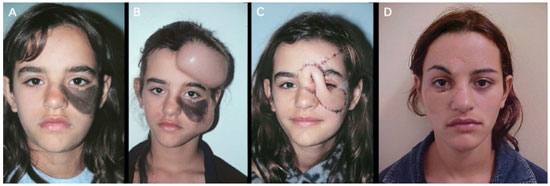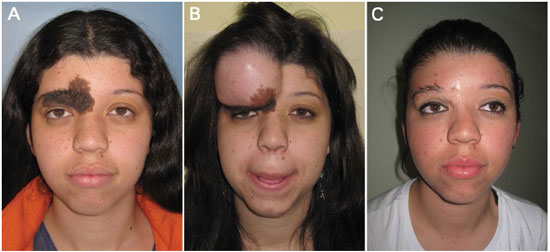

Original Article - Year 2015 - Volume 30 -
Opções terapêuticas no manejo do nevus congênito gigante, experiência do Serviço de Cirurgia Plástica e Reaparadora HC-UFPR
Therapeutic options in the management of giant congenital nevus: Experience of the Plastic and Reconstructing Service at Hospital de Clínicas, Federal University of Paraná
RESUMO
INTRODUÇÃO: O nevus congênito gigante (NCG) possui diversas modalidades de tratamento. A abordagem cirúrgica inclui a ressecção parcial seriada ou excisão total. Objetivo: Demonstrar as principais modalidades terapêuticas utilizadas para o tratamento do NCG e avaliar a incidência da localização, idade e tamanho destas lesões no Serviço de Cirurgia Plástica e Reparadora do Hospital de Clínicas da Universidade Federal do Paraná.
MÉTODOS: Estudo retrospectivo dos pacientes submetidos a tratamento cirúrgico do NCG no período de janeiro de 2004 a janeiro de 2010. Foram coletados dados como: idade, gênero, tratamento realizado, número de cirurgias realizadas, evolução e complicações.
RESULTADOS: Foram avaliados 11 pacientes, sendo 8 mulheres e 3 homens. A média de idade foi de 12,4 anos (3 a 25 anos). O subtipo mais encontrado foi o nevus melanocítico intradérmico correspondendo a 90,9% dos casos e 9,1% com nevus melanocítico composto. Não foram identificados casos de melanoma. A localização mais comum foi a região da cabeça e pescoço. O diâmetro médio das lesões foi de 9,1 cm.As técnicas utilizadas para reconstrução foram: sutura primária, retalhos locais, enxerto de pele e uso de expansores. No seguimento, 63,6% dos pacientes apresentavam ainda nevus residual, 27,3% apresentaram ressecção completa e 9,1% perderam seguimento.
CONCLUSÃO: Foi observada maior incidência de NCG na faixa etária de 3 a 25 anos, sendo a localização mais comum na face e com tamanho médio de 9,1cm. O principal tratamento instituído para os pacientes com NCG foi a ressecção parcelada, com bons resultados.
Palavras-chave: Nevo; Tratamento; Procedimentos cirúrgicos reconstrutivos.
ABSTRACT
INTRODUCTION: Several modalities are available for the treatment of giant congenital nevus (GCN). The surgical approach includes partial serial resection or total excision. Objective: To demonstrate the main therapeutic modalities in the treatment of GCN and to assess the incidence of location, age, and size of this lesion at the Plastic and Reconstructive Surgery Service of the Hospital de Clínicas, Federal University of Paraná.
METHODS: This retrospective study included patients who had undergone surgical treatment for GCN between January 2004 and January 2010. We collected data such as age, sex, treatment performed, number of surgeries carried out, evolution, and complications.
RESULTS: We evaluated 11 patients (8 female and 3 male). The average age was 12.4 years (range, 3-25 years). The GCN subtype most commonly found was intradermal melanocytic nevus, which accounted for 90.9% of cases, with melanocytic nevus accounting for the remaining 9.1%. No cases of melanoma were identified. The most common location was the head and neck. The average diameter of the lesions was 9.1 cm. The techniques used for the reconstruction included primary suture, local flaps, skin graft, and the use of expanders. In the follow-up period, 63.6% of the patients still presented a residual nevus, 27.3% underwent complete resection, and 9.1% were not monitored.
CONCLUSION: A higher incidence of GCN was observed in patients aged 3-25 years. The most common location was the face, and the average size was 9.1 cm. The main treatment of patients with GCN was splitting resection, which resulted in satisfactory outcomes.
Keywords: Nevus; Treatment; Reconstructive surgical procedures.
O nevus congênito gigante (NCG) é uma afecção rara, com incidência aproximada de 1 caso a cada 20.000 nascidos, e desfigurante, causando estresse psicológico tanto para o paciente quanto aos familiares. Esta afecção resulta da coleção anormal de melanócitos de origem neuroectodérmica, em localização ectópica1,2. O risco de degeneração maligna é controverso, com uma variação na literatura de 1,8 a 45% dos casos, aumentando na dependência do número e tamanho das lesões, e da idade do paciente. No entanto, existe um debate em curso sobre a magnitude deste risco e quanto ele se aplica a todos os nevos congênitos ou somente aos maiores. Em estudo de meta-análise, o risco médio de transformação maligna de um NCG foi de 8,2%. Os nevos congênitos pequenos apresentam riscos cumulativos para as pessoas com a idade de 60 anos para 4,9% de malignização3,4.
O objetivo do tratamento consiste na excisão completa das células névicas ectópicas. Existem formas de abordagem cirúrgica e não cirúrgica destas lesões. A abordagem cirúrgica inclui ressecção parcial seriada ou excisão total. Em casos que são passíveis de ressecção completa e fechamento por sutura primária, esta deve ser a conduta. Pode também se utilizar de enxertia ou retalhos cutâneos para a cobertura da ferida resultante da ressecção. A utilização de expansores cutâneos é uma alternativa para casos de maior dimensão, necessitando de, no mínimo, dois tempos cirúrgicos2.
OBJETIVO
Pretende-se, neste trabalho, verificar as principais modalidades terapêuticas utilizadas para o tratamento do NCG, além de avaliar a incidência da localização, idade e tamanho destas lesões, no Serviço de Cirurgia Plástica e Reparadora do Hospital de Clínicas da Universidade Federal do Paraná.
MÉTODOS
Estudo transversal dos pacientes com NCG submetidos a tratamento cirúrgico no Hospital de Clínicas da Universidade Federal do Paraná, no período de janeiro de 2004 a janeiro de 2010. Os pacientes foram identificados pelo livro de registros de cirurgias realizadas. Foram coletados os seguintes dados, por meio de revisão dos prontuários: idade, sexo, tipo de tratamento realizado, número de cirurgias realizadas, evolução e complicações. Projeto registrado no Sistema Nacional de Informações Sobre Ética em Pesquisa envolvendo Seres Humanos.
RESULTADOS
Foram avaliados 11 pacientes, sendo oito mulheres (72,7%) e três homens (27,3%), com um total de 17 lesões. A média de idade dos pacientes na época da cirurgia foi de 12,4 anos, variando de 3 a 25 anos. Com relação à histologia, o subtipo mais encontrado foi o nevus melanocítico intradérmico, totalizando 10 pacientes (90,9%), e um paciente (9,1%) apresentou nevus melanocítico composto. Não foram identificados casos de melanoma. A localização mais comum das lesões é na região da cabeça e pescoço (Figura 1). Três pacientes apresentavam mais de uma lesão névica, variando de duas a quatro lesões. O tamanho médio das lesões, avaliado pelo maior diâmetro, foi de 9,1 cm (2,1 a 30 cm).

Figura 1. A: Nevus melanocitico congênito em malara esquerda; B: Imagem após colocação do expansor para preparação do retalho; C: Imagem após exérese do nevus e rotação do retalho frontal para fechamento da a'rea ressecada, mantendo ainda o pedículo vascular do retalho; D: Imagem ap'so liberaçãoo do pedículo do retalho.
A técnica cirúrgica mais utilizada foi rotação de retalho local (Figura 2). O número médio de cirurgias realizadas por paciente foi de dois procedimentos, variando de um a cinco.

Figura 2. A: Nevus melanocitico congênito em região frontal e área de sobrancelha; B: Imagem após colocação do expansor para preparação do retalho; C: Imagem após exérese do nevus e rotação do retalho frontal para fechamento da a'rea ressecada.
Ocorreram duas complicações: um paciente apresentou cicatriz hipertrófica leve em axila esquerda e outro paciente com cicatriz inestéstica em face, porém, com história de ter realizado dermoabrasão em outro serviço. A evolução dos pacientes está representada abaixo (Figura 3).

Figura 3. Nevus melanocitico congênito em região de hemiface direita e dorso nasal; B: Imagem após colocação do expansor para preparação do retalho; C: Imagem após exérese do nevus e rotação do retalho frontal para fechamento da a'rea ressecada.
DISCUSSÃO
Define-se como nevus congênito gigante lesões névicas com diâmetro maior que 20 cm em adultos ou que ocupem acima de 1% da superfície de cabeça e pescoço e 2% da superfície corporal em outras localizações1,5. A abordagem destas lesões tende a ser precoce, principalmente na infância e idade prépuberal, objetivando evitar o risco de malignização que ocorre em 50% dos casos até o terceiro ano de vida, e 75% até a puberdade. Em nosso serviço, a maioria dos pacientes iniciou tratamento em idade puberal por provável dificuldade de acesso e atraso na procura de atendimento adequado.
As lesões múltiplas são comuns e demandam estudo mais detalhado da abordagem terapêutica. Múltiplos nevus ocorreram em aproximadamente um terço de nossos casos, porém, não alteraram nossa conduta. Os métodos minimamente invasivos como dermoabrasões, curetagem, terapia a laser, shave excision e peeling químico são modalidades terapêuticas menos traumáticas, mas não diminuem o risco de malignização das lesões e podem dificultar a monitorização clínica por não remover as células melanocíticas8. Assim são proscritas em nosso serviço.
A abordagem desta afecção é múltipla e individualizada para cada caso. Em nosso serviço, optou-se por realizar a ressecção parcial seriada das lesões, obtendo-se bom resultado estético e seguimento aceitável durante longo período. Apenas dois pacientes perderam seguimento. Em outros três casos foi possível a ressecção completa. Modalidades de tratamento combinadas são muitas vezes necessárias, principalmente em lesões na região da cabeça e pescoço, por envolver diferentes estruturas anatômicas. Ressecções parceladas associadas ao uso de expansores tissulares foram por nós utilizadas.
É necessário amplo conhecimento deste tipo de lesão com estudos dirigidos à história natural, complicações e mesmo genética. É importante obter controle rigoroso das lesões residuais, ampliação das formas de tratamento com desenvolvimento de novas técnicas quando necessário. O aprimoramento da técnica operatória com o uso de expansores teciduais, enxertos sintéticos, associação de tratamentos não cirúrgicos e cirúrgicos têm melhorado a qualidade das cicatrizes e diminuído as lesões residuais.
CONCLUSÃO
Foi observada maior incidência de NCG na faixa etária de 3 a 25 anos, sendo a localização mais comum na face e com tamanho médio de 9,1 cm. O principal tratamento instituído para os pacientes com NCG foi a ressecção parcelada, com bons resultados.
REFERÊNCIAS
1. Williams ML, Pennella R. Melanoma, melanocytic nevi, and other melanoma risk factors in children. J Pediatr. 1994;124(6):833-45. DOI: http://dx.doi.org/10.1016/S0022-3476(05)83168-3
2. Castilla EE, da Graça Dutra M, Orioli-Parreiras IM. Epidemiology of congenital pigmented naevi: I. Incidence rates and relative frequencies. Br J Dermatol. 1981;104(3):307-15. PMID: 7213564 DOI: http://dx.doi.org/10.1111/j.1365-2133.1981.tb00954.x
3. Krengel S, Hauschild A, Schäfer T. Melanoma risk in congenital melanocytic naevi: a systematic review. Br J Dermatol. 2006;155(1):1-8. PMID: 16792745 DOI: http://dx.doi.org/10.1111/j.1365-2133.2006.07218.x
4. Zaal LH, Mooi WJ, Sillevis Smitt JH, van der Horst CM. Classification of congenital melanocytic naevi and malignant transformation: a review of the literature. Br J Plast Surg. 2004;57(8):707-19. PMID: 15544766 DOI: http://dx.doi.org/10.1016/j.bjps.2004.04.022
5. Ruiz-Maldonado R, Tamayo L, Laterza AM, Durán C. Giant pigmented nevi: clinical, histopathologic, and therapeutic considerations. J Pediatr. 1992;120(6):906-11. PMID: 1593350 DOI: http://dx.doi.org/10.1016/S0022-3476(05)81958-4
6. Heffel DF, Thaller S. Congenital melanosis: an update. J Craniofac Surg. 2005;16(5):940-4. DOI: http://dx.doi.org/10.1097/01.scs.0000179751.29284.51
7. Clemmensen OJ, Kroon S. The histology of "congenital features" in early acquired melanocytic nevi. J Am Acad Dermatol. 1988;19(4):742-6. DOI: http://dx.doi.org/10.1016/S0190-9622(88)70231-5
8. Arneja JS, Gosain AK. Giant congenital melanocytic nevi of the trunk and an algorithm for treatment. J Craniofac Surg. 2005;16(5):886-93. DOI: http://dx.doi.org/10.1097/01.scs.0000183356.41637.f5
9. Lanier VC Jr, Pickrell KL, Georgiade NG. Congenital giant nevi: clinical and pathological considerations. Plast Reconstr Surg. 1976;58(1):48-54. PMID: 935278 DOI: http://dx.doi.org/10.1097/00006534-19760700000008
10. Kopf AW, Bart RS, Hennessey P. Congenital nevocytic nevi and malignant melanomas. J Am Acad Dermatol. 1979;1(2):123-30. DOI: http://dx.doi.org/10.1016/S0190-9622(79)70009-0
Universidade Federal do Paraná, Curitiba, PR, Brasil
Instituição: Serviço de Cirurgia Plástica e Reaparadora HC-UFPR, Curitiba, PR, Brasil.
Autor correspondente:
Renato da Silva Freitas
Rua General Carneiro, 191
Curitiba, PR, Brasil CEP 80860-900
E-mail: dr.renato.freitas@gmail.com
Artigo submetido: 21/12/2011.
Artigo aceito: 15/3/2015.


 Read in Portuguese
Read in Portuguese
 Read in English
Read in English
 PDF PT
PDF PT
 Print
Print
 Send this article by email
Send this article by email
 How to Cite
How to Cite
 Mendeley
Mendeley
 Pocket
Pocket
 Twitter
Twitter